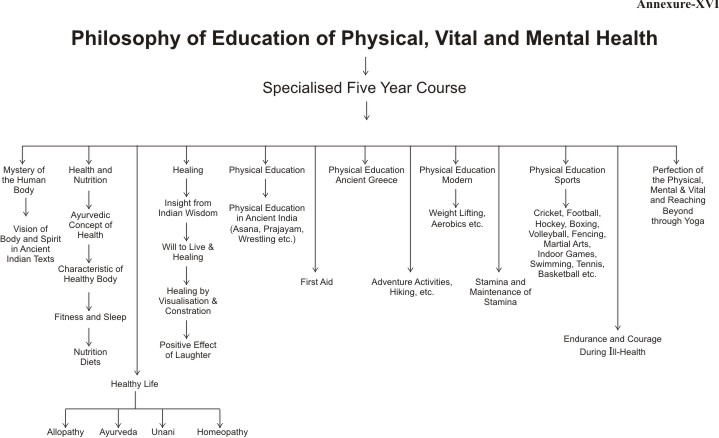Child Teacher and Teacher Education - Annexure 1 to 16
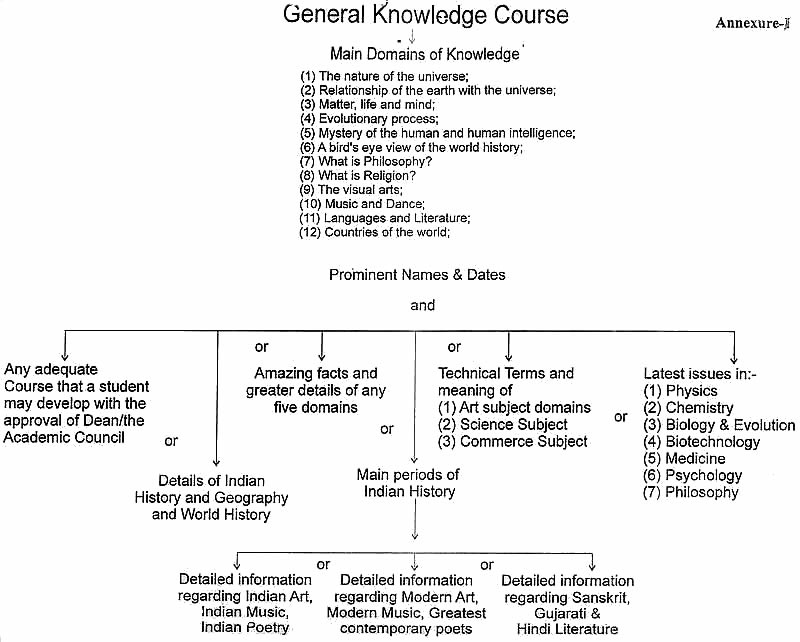
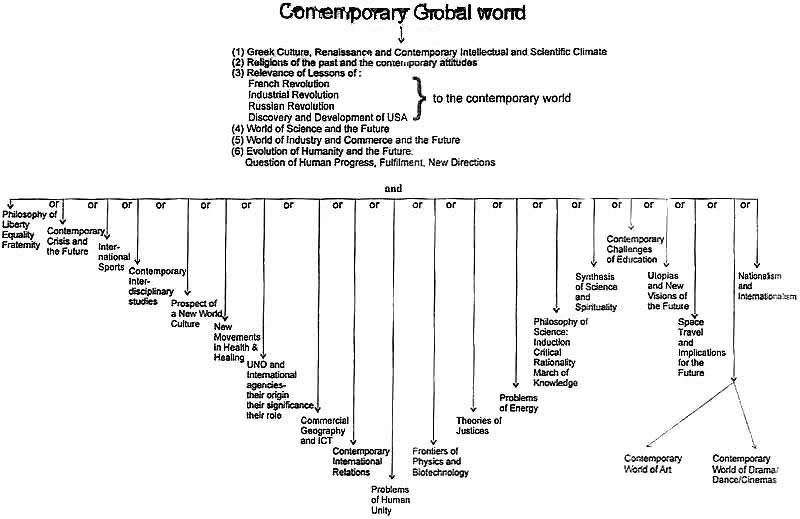
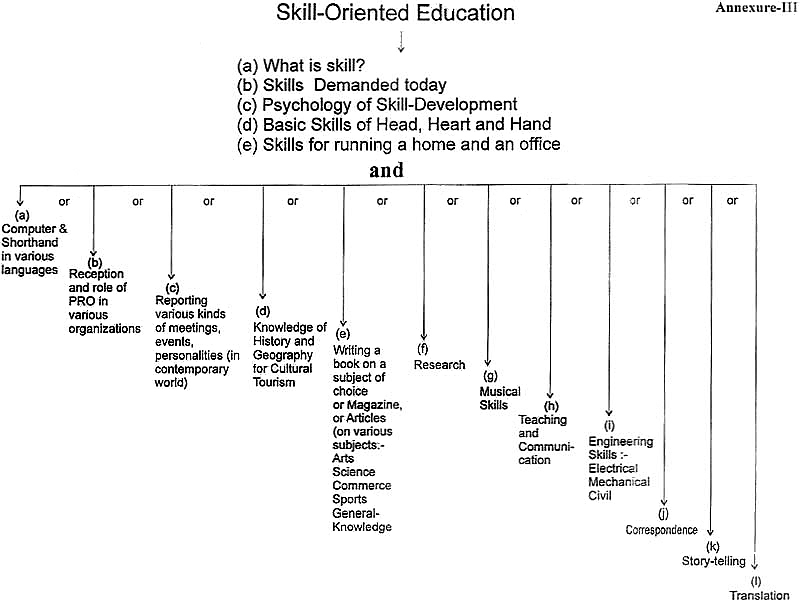

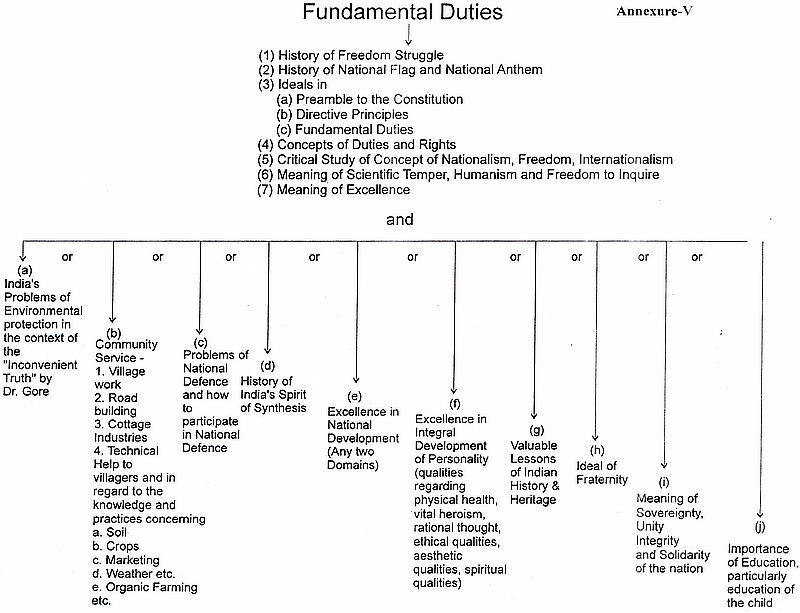
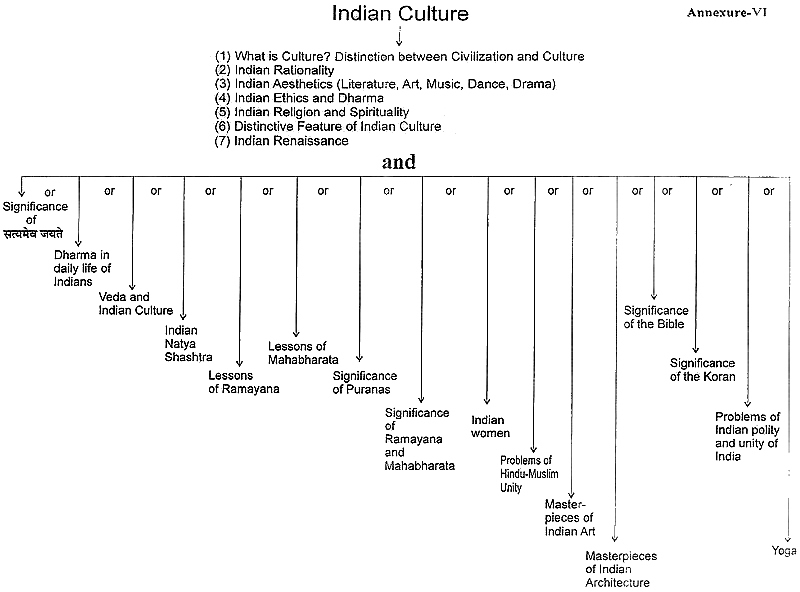
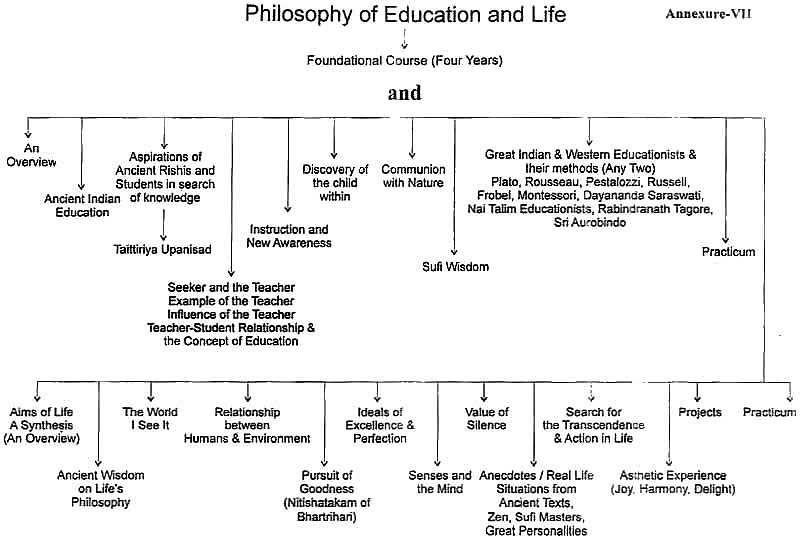

ANNEXURE IX
Education for Integral Development of Personality
To Know Oneself and to Control Oneself
(An Exploratory Draft Programme)
Classes I and II
- Stories and plays to illustrate the following themes:
- The ideal of truth: To speak the truth, whatever the consequences.
- Aspiration for perfection: Whatever you do, do it as perfectly as you can.
- Dreams of the new world: Where truth alone prevails, where beauty and goodness pervade.
- Special exhibitions on the above themes.
- Teachers may recommend the following exercises and help each child to practise them:
- Exercises in remembering and repeating noble aspirations and thoughts.
- Exercises in observations and accurate description (leaves, plants, flowers, minerals, scenes, animals, figures, human body, artistic pictures, musical pieces, building, objects, events).
- Art of bathing, art of cleaning the teeth, art of dreaming, art of sitting and standing in right postures.
- Exercises in control of the senses:
- Control in regulating calls of nature, thirst and appetite;
- Control in speech;
- Control in behaviour;
- Control in movement and action.
Classes III and IV
- Development of the sense of wonders:
- Examples from astronomy: distance, vastness, galaxies, expanding universe.
- Examples from physics: what is matter behind what we see and touch?
- Examples from chemistry: what is water? Is it mere oxygen and hydrogen or something more?
- Examples from other sciences: caterpillar and butterfly, language and understanding, outer man and inner man.
- Training of the senses and their powers:
- Knowledge of the senses: five senses of knowledge, five senses of action.
- Exercises of vision and hearing: art and music as instruments.
- Exercises of concentration in sense activities.
- Inner senses: capacities to see the invisible and to hear the inaudible.
- Awareness of the body:
- Elementary knowledge relating to health, strength and beauty of the body.
- Art of relaxation and art of sleeping.
- The body as the temple of the spirit.
- Teachers may recommend, according to circumstances, the following attitudes and exercises:
- One should study, not to pass examinations, but to discover the secrets of the world.
- Work with the body is indispensable for true knowledge and experiences.
- Practise of concentration in every activity: concentration is the key to all progress.
- Practise of quietude and silence in “Rooms of Silence”.
- Impromptu periods or moments when children are asked to be as quiet as possible.
Directions to Teachers (Class I – IV)
Some practical hints that result form the application of methods of psychological and value-oriented development are suggested here:
- It may first be noted that a good many children are under the influence of the inner psychic presence which shows itself very distinctly at times in their spontaneous reactions and even in their words. All spontaneous turning to love, truth, beauty, knowledge, nobility, heroism is a sure sign of the psychic influence.
- To recognise these reactions and to encourage them wisely and with a psychic feeling would be the first indispensable step.
- The best qualities to develop in children are:
sincerity perseverance
honesty peace
straightforwardness calm
cheerfulness self-control
courage self-mastery
disinterestedness truth
patience harmony
endurance liberty
-
These qualities are taught infinitely better by examples than by beautiful speeches.
-
The undesirable impulses and habits should not be treated harshly. The child should not be scolded. Particularly, care should be taken not to rebuke a child for a fault which one commits oneself. Children are very keen and clear-sighted observers; they soon find out the educator’s weaknesses and note them without pity.
-
When a child makes a mistake, one must see that he confesses it to the teacher or the guardian spontaneously and frankly; and when he has confessed it he should be made to understand with kindness and affection what was wrong in the movement and that he should not repeat it. A fault confessed must be forgiven.
-
The child should be encouraged to think of wrong impulses not as sins or offences but as symptoms of a curable disease alterable by a steady and a sustained effort of the will – falsehood being rejected and replaced by truth, fear by courage, selfishness by sacrifice, malice by love.
-
Great care should be taken to see that unformed virtues are not rejected as faults. The wildness and recklessness of many young natures are only the overflowing of an excessive strength, greatness and nobility.
- An affection that is firm yet gentle, sees clearly, and a sufficiently practical knowledge will create bonds of trust that are indispensable for the educator to make the education of a child effective.
- When a child asks a question, he should not be answered by saying that it is stupid or foolish, or that the answer will not be understood by him. Curiosity cannot be postponed, and an effort must be made to answer questions truthfully and in such a way as to make the answer comprehensible to his mental capacity.
- The teacher should ensure that the child gradually begins to be aware of the psychological centre of his being, the psychic being, the inner seat of the highest truth of our existence.
- With that growing awareness, the child should be taught to concentrate on his presence and make it more and more a living fact.
- The child should be taught that whenever there is an inner uneasiness, he should not pass it off and try to forget it, but should attend to it, and try to find out by an inner observation the cause of the uneasiness, so that it can be removed by inner or other methods.
- It should be emphasised that if one has a sincere and steady aspiration, a persistent and dynamic will, one is sure to meet in one way or another, externally by study and instruction, internally by concentration, revelation or experience, the
help one needs to reach the goal. Only one thing is absolutely indispensable, the will to discover and realise. This discovery and this realisation should be the primary occupation of the being, the pearl of great price which one should acquire at any cost. Whatever one does, whatever one’s occupation and activity, the will to find the truth of one’s being and to untie with it must always be living, always present behind all one does, all that one thinks, all that one experiences.
All the above suggestions are to be implemented from day to day under various circumstances and in the context of living problems of the growth of children.
The role of the teacher is to put the child upon the right road to its own perfection and encourage it to follow it, watching, suggesting, helping, but not imposing or interfering. The best method of suggestion is by personal example, daily conversation and books read from day to day.
Class V
- Science and Values: A simple statement of the major facts of evolution:
- Emergence of matter.
- Emergence of life in matter.
- Emergence of mind in life.
- Man is evolving.
- Striking phenomenon of the mutation of a caterpillar into a butterfly.
- Future possibilities of the evolution of man. Yoga is a scientific and methodised effort of the evolution of man.
- Aids for the Development of Value-Consciousness and Experience:
- To ask oneself: what am I?
- Story of the search of Svetaketu and Nachiketas.
- Listening to music: selected ragas (Indian) and harmonies (Western)
- Picture of the beauty of nature.
- Study of great personalities: the Buddha (a detailed study).
- Need for physical fitness: what it means (topic for study and reflection).
- Teachers may recommend the following exercises according to circumstances and in response to the individual needs of each student:
- Resolve daily to be truthful, to be free from fear and to have goodwill for everyone.
- Works of labour and community service with an inner motive of dedication.
- Clarity of thought: there is a distinction between appearance and reality (Examples from science, history, literature and philosophy).
- Cleanliness and purity of the body, exercises for the body.
Class VI
- Science and Values
Striking facts revealed by science:
- Extraordinary phenomenon of intelligence in animals and birds.
- Possibility of intelligence even in matter or material objects.
- Complex organisation of social life in certain species of insects, animals and birds.
- Man’s intelligence: is it superior to the intelligence of animals and birds in every respect.
- Value-oriented methods of developing intelligence and knowledge:
- Concentration – silencing of the mind
- Intense search for the truth
- Sincerity in thought, word and deed
- Deep humility
- Aids for Developing of Value-Consciousness and Experience:
- Study of great personalities: Jesus Christ (a detailed story).
-
- Introspection: distinction between thought, will, emotion, impulse, sensation, perception, and functions of the body.
- Story of Arjuna at the beginning of the Mahabharata War to illustrate the above distinctions (other similar stories)
- Determination of the aim of life:
- The Meaning of an idea
- Ideals of truth, beauty and goodness
- Ideal of perfection
- Listening to music: selected ragas (Indian) and harmonies (Western).
- Examples of poetic excellence: regional poetry, Sanskrit poetry, English poetry.
- Need to control and master the lower nature (topic for study and reflection).
- Diet and health.
- Exercises to be recommended:
- To makes in daily life the choice for control and mastery, for regularity and punctuality; the choice for truth and perfection, for work and perseverance to the end of the work, for seriousness of purpose and inner joy and equality in all circumstance.
- To remember the aim of life and to:
- Review daily before retiring one’s actions, thoughts, feelings, in relation to the aim of life.
- Try to harmonise thoughts, words, feelings and deeds to as to progress more in this direction.
- To observe in oneself and to practise through daily effort and exercise:
- Creative urge towards poetry, music, art, crafts, dance, drama, reading, writing.
- Capacities to feel wideness, intensity and height of consciousness and experience.
- Works of labour and community service with an inner motive of dedication – learning the art of sweeping rooms, courtyards, washing of dishes and clothes, and elements of first aid.
- Enlarge interests: there is no subject which is not interesting.
- Will always for health, strength, agility, plasticity and beauty. Remember: it is not virtue to fall ill. If ill:
- Examine diet
- Examine habits
- Examine feelings, thoughts and actions – correct them and recover health.
- Daily one hour of relaxation and games, etc.
Class VII
- Science and Values
- How are plants different from animals?
- Do plants and trees have feelings?
- Experiments of Jagdish Chandra Bose.
- Experiments of effects of music on plants.
- Study of flowers as symbols of psychological states and powers.
- Aid for the Development of Value-Consciousness and Experience:
- Calm and intimate company of plants, trees and flowers.
- A study of the:
- Stories of Bodhisattva from the Jatakas.
- Parables from the Bible.
- Questions put to Yuddhishthira on the bank of the lake and his answers.
- Messages received by Prophet Mohammad from the Angel.
- Account of Rabindra Nath Tagore’s experience of his opening to poetic inspiration.
- “Powers of the Mind” – from Swami Vivekananda.
- Topic for deep study and reflection: how to progress continuously?
- Study of great personalities: Prophet Mohammad (a detailed study).
- Methods for the development of the following qualities and skills:
- Quietude
- Interest in languages
- Poetry and music
- Clarity of thinking
- Will-power
- Exercises to be recommended:
- Develop awareness.
- Go deep, very deep within in search of the soul. (Concentrate on the region of the “solar plexus” and collect all your consciousness, and go deeper and deeper in that region, with quietude, and practice this often.)
- Study repeatedly and practise the message given in:
- The description of the Sthithaprajna as given in the Gita.
- “The Sermon on the Mount”, from the New Testament.
- “If you hast the work, this is they work”, by Sri Aurobindo.
- Works of labour and community service with an inner motive of dedication.
- Daily one hour of exercises, games, etc.
Class VIII
- Science and Values:
- Surprising mysteries of the human body as revealed by science.
- Value-oriented concept of the body:
- The body as the temple of the spirit.
- The subtle body and its functions.
- The concept of chakras (centres of vibrations) and their functions.
- The concept of kundalini: how it can be awakened in different ways.
- Yogic concept of the perfection of the body by a total psychological transformation.
- Aids for the Development of Value-Consciousness and Experience:
- The ideal and practice of brahmacharya (example of Dayananda Saraswati).
- Study of passages from Plato, particularly from the Apology and The Republic.
- Study of passages from the Upanishads, particularly Isha Upanishad.
- Contemplation on the concept of “Universals”.
- Topic for deep study and reflection: “What is my role in the world?”
- Reflection:
- What is the aim of learning languages? How to enrich knowledge of languages?
- What is the essence of mathematics?
- What is science?
- Is language a science?
- Is mathematics a science?
- Is history a science?
- Is geography a science?
- What is the difference between science and art?
- A detailed study of the life and work of Tiruvalluvar.
- Daily one hour of exercises and games, etc.
Class IX
- Science and Values:
- The concept of matter in modern science and yoga.
- The concept of life in modern science and in yoga.
- Importance of the sun and its energy for the life on the earth.
- The nature of the light of the sun (Saura Agni): how it is different from the light of ordinary fire (Jada Agni) and electricity (Vidyut Agni).
- The concept of Agni in yoga.
- Speed of light: its importance in science. Position of an object moving at the speed of light. The concept of the mobile-immobile. Compare this with: “It moves, It moves not” – the Upanishadic description of reality.
- The concept of time in modern science.
- Speed of consciousness exceeds that of light according to yogic knowledge.
- Aids for the Development of Value-Consciousness and Experience:
- What is the process of thinking? How is thinking different in science from that in philosophy?
- What is technology? How should technology be learnt?
- What is the difference between art and technology?
- Observation of the different levels of being in man: the distinction between the physical man, the vital man, the mental man, the spiritual man and the integral man.
- Topic for deep study and reflections: “Unity of knowledge” or “All knowledge, scientific, philosophic or yogic, tends ultimately to be identical.”
- Exercises to be recommended:
- Repeated study and contemplation of Chapter XI of the Bhagavad Gita.
- Vow of the Buddha
- Selected Psalms
- Islamic prayers
- Selected portions from Tulsidas
- Songs of Mirabai, Surdas, Tukaram, Ramprasad, and other saints
- Prayer of Swami Vivekananda
Class X
- Sciences and Values:
- Our knowledge regarding man:
- Man in evolution
- Has man made progress?
- Limitations of man
- The phenomenon of death. What is death? (in the physical, psychological and yogic senses). Can death be conquered?
- Dependence of bodily life on respiration, food, blood circulation and sleep. Is this dependence necessary or indispensable?
- The yogic powers of mastery over food, sleep, respiration and blood circulation. Limitation of these powers; dangers of these powers, real perfection.
- The right attitude towards food, sleep, respiration and other limitations of the body. Need for temperance: avoidance of extremes. Need for change of consciousness. Mastery over bodily limitations possible only at the highest levels of yoga.
- The concept of the divine body.
- Our knowledge regarding man:
- Aids for the Development of the Yogic Consciousness and Experience:
- Elementary powers of expression. Necessity and methods of development of these powers, particularly, in relation to:
- Faultless language expression.
- Faultless bodily expressions: recitation, singing, eurhythmics and dramatics.
- Faultless deeper expressions: poetry, dance, art and craft.
- Elementary powers of perceptions. Necessity and methods of development of these powers, particularly in relation to:
- Refined vision and audition, appreciation of art and music.
- Inner yogic visions and voices.
- Sympathetic feeling and understanding, experience of cooperation, harmony, mutuality and oneness.
- Elementary powers of action. Necessity and methods of development of these powers, particularly in connection with:
- The relationship between knowledge and action.
- The relationship between ideal and practice.
- The relationship between dedication and heroism.
- Works of labour and community service with an inner motive of dedication.
- Study of great personalities (A detailed study of life of Mahavira)
- Why and how to study? (A topic for study and reflection.)
- Exercises to be recommended:
- Remember and practise in daily life:
- Work, not to come first, but to do your very best.
- You have no right to criticise anybody, unless you can do better than the one whom you want to criticise.
- Cultivate in yourself those qualities which you want others to cultivate.
- Select books, magazines, and films with utmost care, and under the guidance of some teachers whom you trust.
- Do not indulge; do not kill your emotions, but learn the difficult art of control, purification, mastery and transformation.
- You have within yourself an inner soul, full of purity, joy and love and light. You are to discover it and bring it forward in all your activities, thoughts and feelings.
- Continue to enlarge interests.
- Continue to will for health, strength, agility, plasticity and beauty.
- Daily one hour of exercise and games, etc.
- Remember and practise in daily life:
- Programmes of Self-Education. The following exercises may be recommended:
- Observation and developments of the natural tendencies, preferences, inclinations and interests.
- Where have I reached in my progress?
- What are my defects?
- How to face defects without depressions?
- What should I do to overcome my defects?
- Preparation of a programme of self-discipline.
- Am I talking too much? To learn to speak only what is necessary.
- Am I lazy? To resolve to remove idleness.
- How to organise my life and my activities?
- Study of selections from Valmiki and Vyasa
- A detailed study of the life and work of Guru Nanak.
Class XI
- Science and Values:
- The role of intuition in discoveries and inventions of science. Yoga as a conscious methods of the development of intuition.
- Ancient Indian sciences and yoga.
- Ancient Indian knowledge and modern scientific knowledge; some striking examples.
- Systems of yoga: Hatha Yoga, Raja Yoga, Karma Yoga, Jnana Yoga, Bhakti Yoga, Tantra, Integral Yoga.
- Aids for the Development of the Yogic Consciousness and Experience:
- Need for the systematic knowledge of the principles and methods of yoga.
- Need for the Teacher: the real inner Teacher.
- Need for inner aspiration in the student.
- The right attitude towards time: to do everything as quickly and perfectly as possible.
- Study of great personalities: Sri Ramakrishna and Swami Vivekananda (a detailed study).
- Exercises to be recommended:
Reflections on:- Scientific and philosophical methods of knowledge.
- Can science and philosophy explain the ultimate reason of events and processes of the world?
- Value and limitations of the philosophical concepts of:
- Deism
- Pantheism
- Theism
- Monism
- Omnipresence, omniscience and omnipotence of God.
- Value and limitations of the philosophical proofs of the existence of God.
- Can God be experienced? Affirmation of spiritual experiences. Varieties of spiritual experience. Yoga as a systematic knowledge of spiritual experience.
Class XII
- Science and Values:
- Yoga as an exploration of existence by an enlargement of consciousness.
- Yoga, like science, is a systematic body of knowledge.
- Yoga, like science, is non-dogmatic.
- Yoga, like science, accepts the criterion of verification by experience.
- Yoga is science, per excellence (statements from Swami Vivekananda on this subject).
- Materialism, science and yoga.
- Need for the synthesis of science and spirituality.
- Science and the discovery of the fourth dimension.
- Discovery of the manifold dimensions of human personality.
- Central Experience of Inner Consciousness:
- Experience of the true individuality:
- Experience of the Witness Self.
- Experience of the Psychic Being in formation.
- Experience of the discovery of the Psychic Being – experience of the second birth.
- Experience of Silence or of nirvana.
- Experience of the Cosmic Consciousness.
- Integral experience of the simultaneous Silence and Dynamism.
- Supramental time-vision.
- Experience of the true individuality:
- Aids for the Development of the Yogic Consciousness and experience:
A brief study of the following topics:- All life must be accepted, but all life must be transformed.
- Works of knowledge
- Works of love
- Works of life-force
Problems in accepting and transforming these works.
- Synthesis of the four main theories of the aim of life:
- Supracosmic
- Supraterrestrial
- Cosmic-terrestrial
- Integral
- Development of a vision of ideal perfection, individual and collective.
- Man’s present condition and possibilities of his further evolution.
- Psychological experiences of various parts and domains of being. Conflicts between the rational being, the aesthetic being and the ethical being. How to resolve these conflicts?
- All life must be accepted, but all life must be transformed.
- Exercises to be recommended:
- Sustained exercises of clear thought.
- Intensive introspection.
- Progressive harmonisation of various parts of the being.
- Creative work with sustained enthusiasm and the spirit of perfection in expression.
- Programmes of dedicated community service.
- Consistency in aspiration, effort and dedication.
- Equality in success or in failure, while working constantly for the triumph of the Truth.
- Development of the powers of philosophical reasoning, scientific observation and experimentation, artistic expression, and technological skill. Harmonisation of these powers by rigorous internal exercises of will.
- Programmes of Self-Education:
To discover within oneself the secret guide and teacher and to take up the charge of educating oneself progressively and integrally.
ANNEXURE-X
Education through Indian Culture to Children of India
Class I to IV
The first lesson may underline the concept of reverence to the highest, which is common in all parts of India, and which transcends barriers of religions and beliefs. The most important phrase is: namaao nama:— namo namah: — salutation, and salutation again. The message of this phrase has become embedded in the entire style of life in India and even in greetings to each other Indians make various gestures of salutations.
Truth is another word that has to be underlined. The search for the Truth supersedes every other search in Indian culture.
The story of the Buddha to be told to the children in detail – his search for the truth was so intense that he renounced all else, -- his kingdom, his wife, his child, -- everything that was dear and near, everything that was pleasant.
Renunciation (त्याग) is another important common element in Indian culture. India celebrates renunciation and values it most.
The story of the search for the Truth and renunciation is further illustrated by the story of Nachiketas.
The story of Nachiketas can be recounted as given in the Kathopanishad. The story of renunciation is also
illustrated through the story of Sri Rama, which can be told to underline Sri Rama’s renunciation and his emphasis on action to uphold the truth.
The story of Harischandra can also be told – it illustrates both Truth and renunciation.
The story of Shivi can also be told in the same connenction.
The ideal of Truth is so much emphasized that India when it became free adopted the following as its official motto: सत्यमेव जयते – satyam eva jayate.
From where is this motto derived, let us make a search.
It would be found in Mandukya Upanishad. What are Upanishads? They are the highest literature of India. It is in the Upanishads that we find the description of ancient India. Kings and princes and ordinary children are found here in search of Truth and they knock on the doors of the huts of the Rishis in the forest.
The seekers of knowledge in search of teachers have since that time remained an ideal feature of Indian culture.
While telling this, the following statements may be emphasized: Our culture is the culture of tyāga.
Even kings used to abdicate their kingdoms in order to seek the highest knowledge and Truth towards the end of their life. The story of Kunti, Gandhadri and Dhritrashtra can be told in this context.
Ten taktyena bhunjita is another concept that can be introduced from the Ishopanishad.
Abdication of desires is the one message in all
religions which are prevalent in India. During the freedom struggle, the idea of abdication was most important. The story of freedom struggle to be told in this connection.
Reference may also to be made o light and sound show of Andaman Nicobar. The story of Bal Gangadhar Tilak, story of Sri Aurobindo, the story of Dr. Rajendra Prasad, Subhash Chandra Bose, Khudiram Bose, Bhagat Singh, Chandrashekhar Azad, etc. This is the India that should be loved and cherished.
Another aspect of Indian culture is "sarva hitaya" work for the benefit of all. Reference from Bhagavadgita, Buddhism, Jainism and Islam, etc., can be told. In this connection, we can tell the story of Sri Rama; for public welfare he sacrificed his personal life; story of Sri Krishna and Arjuna; *** solidarity of people was the ideal given by Sri Krishna to Arjuna; story of goodwill; the story of Christ; Buddha's story of compassion and the idea of sarvodaya, can be emphasised here.
Search for good, love, and joy (ananda). Indian culture is mil of festivals of joy, kavya, sangita, stories of Sri Krishna, Shiva, and Mahalaksmi.
For Class V to XII
Class V
The curriculum of class V may be divided in three parts:
Part I
This part should be devoted to the following topics:
- The story of Sanskrit in India ;
- Important authors, who wrote in Sanskrit, and whose works are memorable ;
- The story of Tamil : famous authors in Tamil and famous works in Tamil
- The story of Pali and authors who wrote in Pali : memorable works in Pali;
- The story of Prakrit : great authors who wrote in Prakrit and memorable works in Prakrit ;
- Origin and development of the modern Indian languages: Names of all modern Indian languages and famous authors and the works in these languages;
- The story of Arabic, Turkish and Persian in India: famous authors and famous works in these languages.
Arrival and development of English in India: famous Indian authors and famous works of Indian authors in English.
Part II
Two greatest works of India in Sanskrit: The Ramayana and The Mahabharata.
An outline of the contents of there two works.
Part III
Definition of Culture.
What is Indian Culture?
Spirituality, brilliance of intellectuality and profusion of creativity.
Class VI
(Note: Curriculum of class VI to VIII in Indian culture may be prescribed only for those students, who want to pursue the course of Indian culture at an
advanced level. For those who do not wish to do so, may be allowed to take up at this stage, an advanced course in any other subject in which they are interested in a special way.)
Story of Astronomy and Mathematics in India: famous authors in Astronomy and Mathematics and famous works of these famous authors.
The following topics may be emphasized:
- The concept of Brahmanda;
- Ancient Indian concept of the Earth that moves around the sun; The ancient Indian concept of planets. The concept of Gravitation in ancient India.
- Life and works of Varahamihir;
- Invention of the concept of zero;
- Indian Mathematical sciences: Arithmetic, Algebra, Geometry. Measurements and calculations up to highest possible integers and lowest possible fractions;
- An account of great advances in Astronomy and Mathematics in ancient India, which anticipated discoveries of the modern period of the world history.
- Advances in Astronomy and Mathematics in modern India, which absorbed western advances in the modern period.
Class VII
Ancient Indian Physics and Chemistry:
- The concept of five basic elements: ether, air, fire, water, and earth;
- Sankhya theory of evolution and Vaisheshika theory of atom;
- The concept of speed of light;
- Ancient chemistry in India;
- Ancient chemistry and Ayurveda.
Class VIII
Development of Ayurveda in ancient India, and its continuity right up to the present day.
The following topics to be emphasized:
- Knowledge of the human body; anatomy and physiology (in bare outline);
- Concept of Doshas;
- Theory of health and strength in Ayurveda: relationship with Physical exercises of Hatha Yoga;
- Concept of longevity;
- Indian surgery;
- Plastic surgery and its survival right up to the arrival of the British in India;
- Present status of Ayurveda in India;
- Indian games, wrestling, and exercises for physical perfection;
Class IX
- Famous Indian stories: Panchtantra and Hitopadesh and Jataka stories;
- History of Sanskrit drama with special reference to (i) Bharata Muni and Abhinavagupta (ii) famous Sanskrit dramas prior to Kalidasa;
- Kalidasa: his poetry and drama;
- Post-Kalidasian drama;
- Katha Sarit Sagar;
- Use of Prakrit in Sanskrit dramas;
- Bare outline of the great stories and dramas, written in India in Arabic and Persian;
- Bare outline of stories and dramas written in modern Indian languages;
- Indian authors in English: Rabindranath Tagore and Sri Aurobindo.
Class X
The curriculum of class X will be devoted to Indian Art.
Special reference to:
- Indian concept of Art; illustrations in Poetry, Music, Painting, Architecture and Sculpture;
- Various stages of development in Art, particularly paintings.
- Outstanding paintings, right up to Mughal period;
- Indian architecture, temples, palaces, churches, Gurudwaras and others; Mughal architecture in India: Importance of Taj Mahal.
Class XI
- Systems of Indian Philosophy: Main schools and their fundamental doctrines;
- Indian ethics: outline study of ethics and yoga of Geeta.
- Dharmashashtras and Nitishashtras of India;
- Arthshashtra of India (a bare outline);
- Other numerous social sciences;
- Concept of 64 sciences and arts.
Class XII
- Religions in India; spirit of tolerance and synthesis;
- Systems of Yoga and systems of synthesis of Yoga;
- Indian polity and India Renaissance;
- Leaders of Indian Renaissance;
- Problem of contemporary Indian culture and external Influences;
- Towards a great synthesis of the East and the West.
* * *
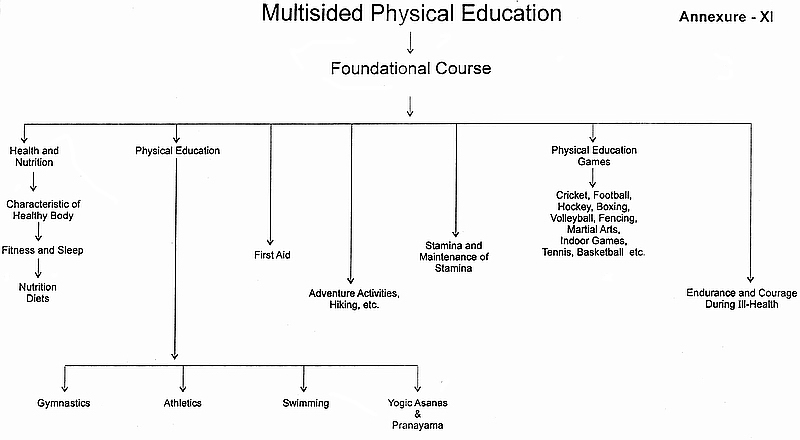
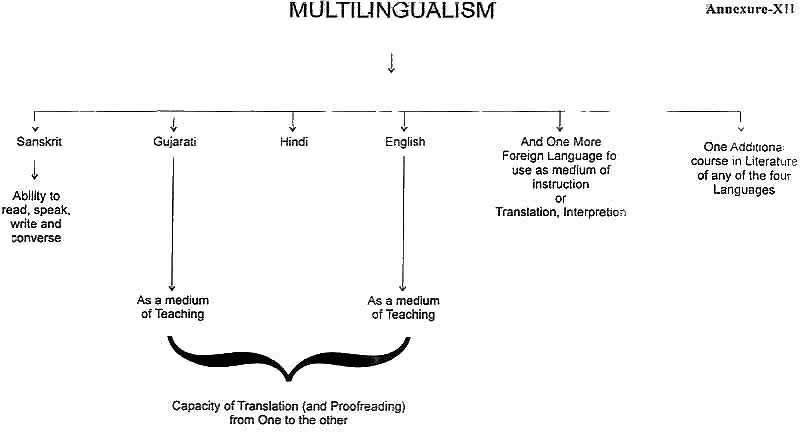
Annexure-XIII
Specialised Courses
(Any 3 Subjects)
- Teaching any One or Two School Subjects
- Teaching New Subjects of Development of Personality
- Teaching Groups of Hobbies
- Teaching Group of Vocational Courses
- Teaching Physical Education
- Teaching Gifted Creativity
- Teaching Differently Abled Children
- Teaching Early Childhood Education (Including Health, Nutrition and First Aid)
- Ayurveda, Allopathy, Homeopathy and Unani
- Teaching Complete Harmony of Body, Mind and Consciousness through Yoga
- Teaching Computer
- Philosophy of Education
- Psychology of Education
- Sociology of Education
- Education of Aesthetics
- Education of Values
- Education about Religions
- Development of Integral Personality
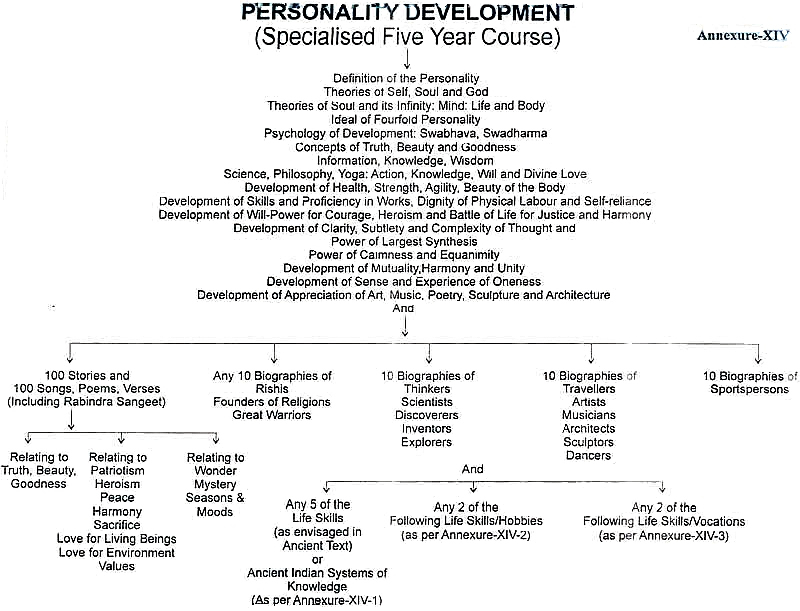
Annexure-XIV-1
Life Skills
Sixty-four Arts mentioned in ancient texts:
- Singing;
- Playing on musical instruments;
- Dancing;
- Union of dancing, singing, and playing instrumental music;
- Writing and drawing;
- Tattooing;
- Arraying and adoring an idol with rice and flowers;
- Spreading and arranging beds or couches of flowers, or flowers upon the ground;
- Colouring the teeth, garments, hair, nails and bodies, i.e. staining, dyeing, colouring and painting the same;
- Fixing stained glass into a floor;
- The art of making beds, and spreading out carpets and cushions for reclining;
- Playing on musical glasses filled with water;
- Storing and accumulating water in aqueducts, cisterns and reservoirs;
- Picture making, trimming and decorating;
- Stringing of rosaries, necklaces, garlands and wreaths;
- Binding of turbans and chaplets and making crests and top-knots of flowers;
- Scenic representations, stage playing;
- Art of making ear ornaments;
- Art of preparing perfumes and odours;
- Proper disposition of jewels and decorations, and adornment in dress;
- Magic or sorcery; .,
- Quickness of hand or manual skill;
- Culinary art, i.e. cooking and cookery;
- Making lemonades, sherbets, acidulated drinks, and spirituous extracts with proper flavour and colour;
- Tailor's work and sewing;
- Making parrots, flowers, tufts, tassels, bunches, bosses, knobs, etc., out of yarn or thread;
- Solution of riddles, enigmas, covert speeches, verbal puzzles and enigmatical questions;
- A game, which consisted in repeating verses, and as one person finished, another person had to commence at once, repeating another verse, beginning with the same letter with which the last speaker's verse ended, whoever failed to repeat was considered to have lost, and to be subject to pay a forfeit or stake of some kind;
- The art of mimicry or imitation;
- Reading, including chanting and intoning;
- Study of sentences difficult to pronounce. It is played as a game chiefly by women and children and consists of a difficult sentence being given, and when repeated quickly, the words are often transposed or badly pronounced;
- Practice with sword, single stick, quarter staff and bow and arrow;
- Drawing inferences, reasoning or inferring;
- Carpentry, or the work of a carpenter;
- Architecture, or the art of building;
- Knowledge about gold and silver coins, and jewels and gems;
- Chemistry and mineralogy;
- Colour jewels, gems and beads;
- Knowledge of mines and quarries;
- Gardening; knowledge of treating the diseases of trees and plants, of nourishing them, and determining their ages;
- Art of cock fighting, quail fighting and ram fighting;
- Art of teaching parrots and starlings to speak;
- Art of applying perfumed ointments to the body, and of dressing the hair with unguents and perfumes and braiding it;
- The art of understanding writing in cipher, and the writing of words in a peculiar way;
- The art of speaking by changing the forms of words. It is of various kinds. Some speak by changing the beginning and end of words, others by adding unnecessary letters between every syllable of a word, and so on;
- Knowledge of language and of the vernacular dialects;
- Art of making flower carriages;
- Art of framing mystical diagrams, of addressing spells and charms, and binding armlets;
- Mental exercises, such as completing stanzas or verses on receiving a part of them; or supplying one, two or three lines when the remaining lines are given indiscriminately from different verses, so as to make the whole an entire verse with regard to its meaning; or arranging the words of a consonants, or leaving them out altogether; or putting into verse or prose sentences represented by signs or symbols. There are many other such exercises;
- Composing poems;
- Knowledge of dictionaries and vocabularies;
- Knowledge of ways of changing and disguising the appearance of persons;
- Knowledge of the art of changing the appearance of things, such as making cotton to appear as silk, coarse and common things to appear as fine and good;
- Various ways of gambling;
- Art of obtaining possession of the property of others by means of mantras or incantations;
- Skill in youthful sports;
- Knowledge of the rules of society, and of how to pay respect and compliments to others;
- Knowledge of the art of war, of arms, of armies, etc.;
- Knowledge of gymnastics;
- Art of knowing the character of a man from his features;
- Knowledge of scanning or constructing verses;
- Arithmetical recreations;
- Making artificial flowers;
- Making figures and images in clay.
Vidyas as mentioned by Narada to Sanatkumar in Chhandogya Upanishad, Chapter VII. 1.2:
- Grammar;
- pitryam the rites for the manes;
- Rashim-mathematics;
- Daivam subject of natural disturbances;
- Nidim mineralogy;
- Vako vakyam logic;
- EkayanamEthics;
- Deva-vidyam Etymology;
- Brahma-vidyam knowledge of the Vedas -Rig, Yajur and Sama regarding pronunciation, ceremonial, prosody and lighting of fire;
- Bhutavidyam science of five elements;
- Kstaravidyam science of archery;
- Nakshatrav-vidyam astrology;
- SarpaVidyam-Science of serpents;
- Devajana-vidyam fine arts.
Annexure - XVI-2
Life Skills / Hobbies
- Chess
- Reading Book are treasure of knowledge and this hobby will certainly come helping a long way in life.
- Playing the Guitar
- Ballroom Dancing
- Woodworking
- Gardening
- Car Restoration
- Metalworking
- Marksmanship
Marksmanship requires pure concentration and a steady hand. - Collecting like postal stamps, first day covers, coins, etc.
- Camping/Backpacking
- Ship in a Bottle
- Whittling
- Geocaching
- Sports: Football, Hockey, Cricket, weightlifting, running, bouldering, kho-kho, kabbadi. Baseball, etc.
- Model Building
- Leatherworking
- Bowling
- Archery
- Letter Writing
- Martial Arts
- Yoga -Asana, Pranayama, Meditation.
- Hiking
- Photography
- Pool/Billiards
- Mountaineering
- Cooking
- Blacksmithing
- Flying
- Magic
- Learning a Foreign Language
- Blogging
- Fencing
- Drawing and Painting
- Amateur Astronomy
- Genealogy
- Adventure Races
- Knitting
- Computer Programming
- Aeromodeling
- Amateur Radio
- Animals/pets/dogs
- Astrology
- Beadwork
- Beatboxing
- Bird watching
- Boating
- Bonsai Tree
- Bringing Food To The Disabled
- Building A House For Habitat For Humanity
- Building Dollhouses
- Butterfly Watching
- Button Collecting
- Calligraphy
- Candle Making
- Canoeing
- Car Racing
- Cloud Watching
- Collecting Antiques
- Collecting Artwork
- Compose Music
- Computer activities
- Crafts
- Crochet/
- Crocheting
- Crossword Puzzles
- Dolls making
- Embroidery
- Freshwater Aquariums
- Frisbee Golf-Frolf
- Go Kart Racing
- Grip Strength
- Handwriting Analysis
- Home Repair
- Horse riding
- Hot air ballooning
- Hula Hooping
- Jewelry Making
- Jigsaw Puzzles
- Juggling
- Kites
- Learning An Instrument
- Learning To Pilot A Plane
- Legos
- Listening to music
- Making Model Cars
- Matchstick Modeling
- Papermaking
- Parachuting
- Piano
- Pottery
- Puppetry
- Pyrotechnics
- Rafting
- Reading
- Reading To The Elderly
- Rescuing Abused Or Abandoned Animals
- Robotics
- Rock Collecting
- Scrap booking
- Skeet Shooting
- Singing In Choir
- Skateboarding
- Sketching
- Sky Diving
- Soap Making
- Storytelling
- Swimming
- Tea Tasting
- Toy Collecting
- Tutoring Children
- Video Games, such as Age of Mythology, etc.
- Writing
- Scale Modeling/Dioramas
- Beautician
- Art of telling Jokes
- Food Decorating
- Basket making
- Rice sculpture
- Animal communication
- Hobbies related to the religions of the world
- Fashion Designing (Specialised course)
- Cosmetics
- Making Perfumes
- Child care
- Diets
- Natural remedies'
- Modeling
- PATIO ART: HOW TO MAKE STAINED GLASS WIND CHIMES FOR YOUR HOME AND GARDEN
- Mosaic Art and Style
Annexure - XVI-3
Life Skills / Vocations
- DRAWING AND PAINTING (Specialisation in any of the five or six)
- Surreal Painting
- Romance
- Madhubani Painting
- Miniature Painting
- Impressionism
- Renaissance Art
- Abstract Paintings
- Semi Abstract Paintings
- Mughal Paintings
- Rajasthani Paintings
- Mathura Art
- Figurative Paintings
- Landscape Paintings
- Ceramics
- Sculpture
- Glass Painting
- Basholi, Guler-Kangra and Sikh Lepakshi Painting
- Batik Painting
- Indian Murals Paintings
- Indian Folk Paintings
- Silk Paintings
- South Indian form of Painting (Thanjavur)
- Atavahana Paintings (2nd century B .C. to 2nd century A,D.)
- Kushana School of Paintings (1st to 3rd century A.D.)
- Gupta Period Paintings (4th too 6th century A.D.)
- Vakataka Paintings (4th to 6th century A.D.)
- Early Western Chalukya Paintings (6th to 8th century A.D.)
- Bhanja Paintings (8th century A.D.)
- Pallava Paintings (7th to 9th century A.D.)
- Early Pandyan Paintings (7th to 9th century A.D.)
- Early Chera Paintings (8th to 9th century A.D.)
- Rashtrakuta Paintings (8th to 10th century A.D.)
- Chola School of Paintings (9th to 13th century A.D.)*
- Hoysala Paintings (llth to 13th century A.D.)
- Kakatiya Paintings (11th to 13th century A.D.)
- Vijayanagara Paintings (14th to 17th century A.D.)
- Nayaka Period Paintings (17th to 18th century A.D.)
- Paintings of Medieval Kerala (16th to 18th century A.D.)
- Pala and Medieval Eastern School of Paintings (9th to 16th century A.D.)
- Medieval Western Paintings (llth to 15th century A.D.)
- Pahari Paintings (16th to 19th century A.D.')
- Deccant or Dakhani Paintings (17th to 19th century A.D.)
- Mysore and Tanjore Traditional Paintings (17th to 19th century A.D.)
- Gujarati painting—glass painting, Kalampari art
- Fabric Painting
- Encaustic Painting-involves working with pigment, wax, and heat
- Chinese/Japanese painting (including Sumi-e), both of which are distinctive and very beautiful styles of brush painting.
- Portraits individuals, groups of people, couples and self-portraits.
- Comic animation
- COMPUTER RELATED COURSES (Five year course)
Computer Teacher Course (5 year course)
1st year- Computer Fundamentals
- Operating System concepts Linux & Unix
- Windows XP/7/Vista
- MS Word
- MS Excel
- MS Power point
- Access & Outlook
- Bharatiya Open Office
- Networking
- Web Server Concepts
- Introduction to FLASH
- TALLY
- Introduction to Basic Java
2nd Year Course;
- PageMaker
- Corel DRaw
- Photoshop
- Editing a layer mask
- Opacity of Layer
- Illustrator
- FLASH
- Leap Office/ISM
Multilingual Web Technology
- Software Engineering Technique
- C/C++
- CCB&MT
- HTML/DHTML
- JavaScript/VB Script
- Asp.net
- Front Page
- Dream Weaver
- Photoshop
- Flash
- GIF Animator Introduction
- Internet/Project
- Concept of Web Server
- TCP/IP
- Java Script
- Oracle
- SQL Server
- Project
3rd to 5th Year:
MULTIMEDIA
- Image Editing
CorelDraw
Photoshop
In Design
- Advance Image Editing
Illustrator - 2D Animation
Flash
Swish MAX
GIF Animator - Audio
Sound Forge - Video-Editing
Premier - 3D Animation
3DMAX
Poser - Maya Software
- Animated Film Projects
- Ecommerce
- Computer Hardware (1 year Course).
- Cooking (National and International Cuisine).
- Classical Dances (Indian Classical e.g. Kathak, Manipuri, Kathkali, Bharatnatyam, Kuchipudi, Oddisi etc.)
- Musical Instruments-Flute, Sitar, Santoor, Tabla etc.
- Vocal Ragas (Indian Ragas)
- Agriculture
- Horticulture
- Floriculture

